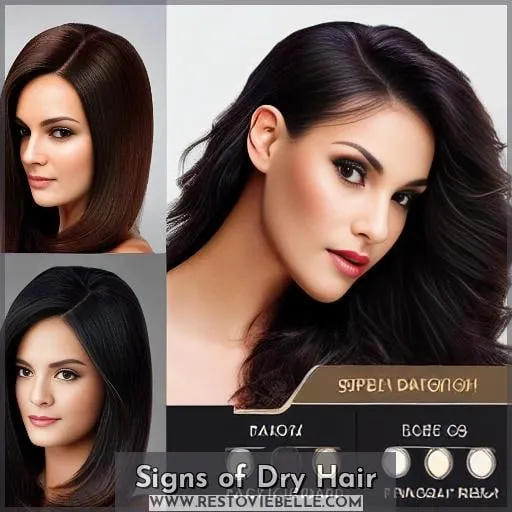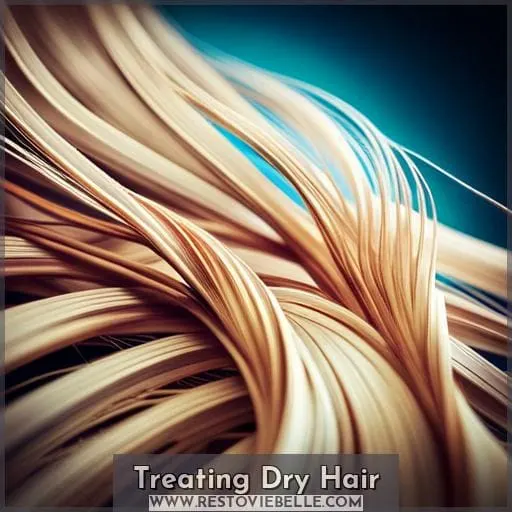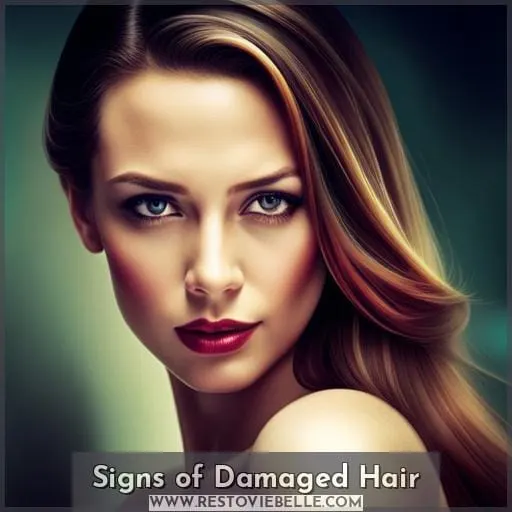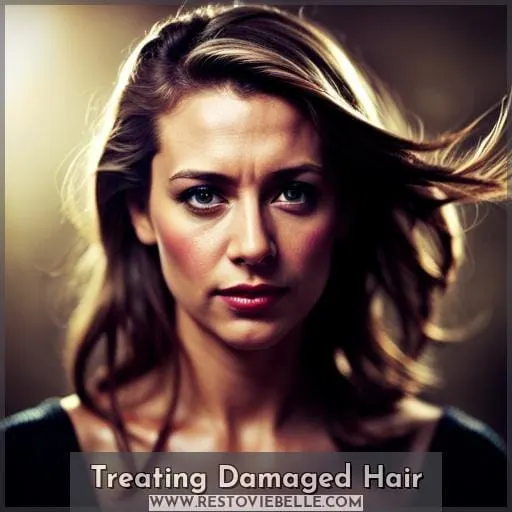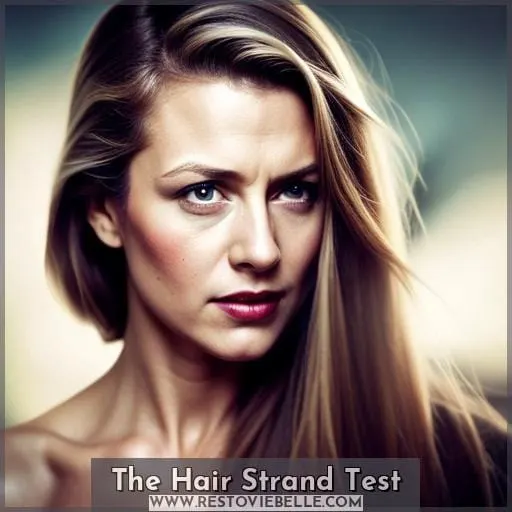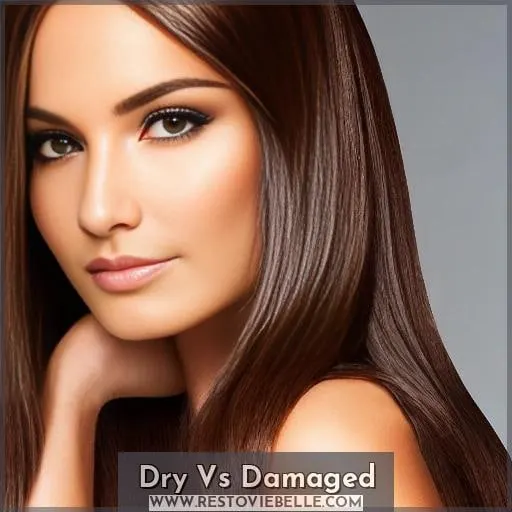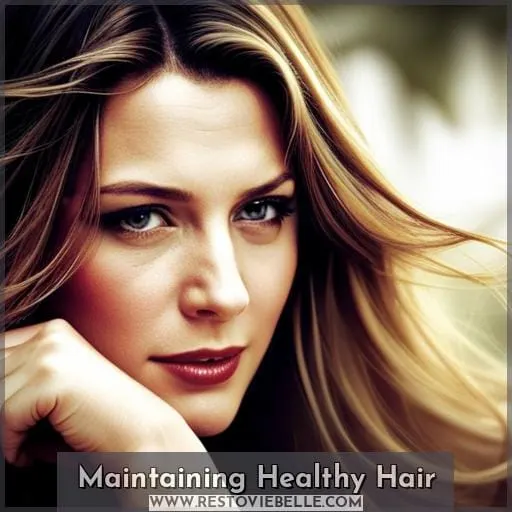This site is supported by our readers. We may earn a commission, at no cost to you, if you purchase through links.
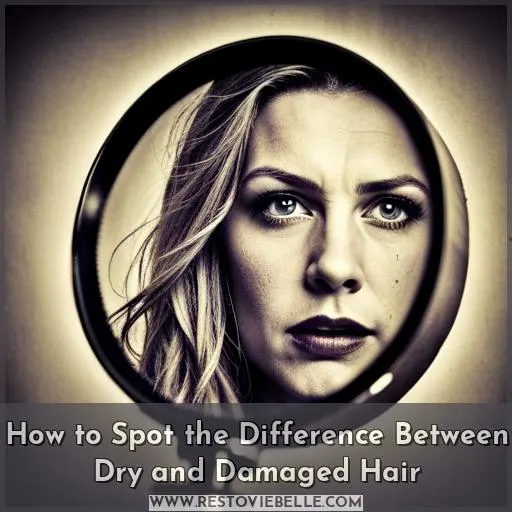 You know what bummed me out today? Realizing my hair’s a frizzy, lackluster mess.
You know what bummed me out today? Realizing my hair’s a frizzy, lackluster mess.
Luckily, I’ve got some clues to investigate. See, dry hair lacks moisture – but the hair shaft’s still intact. Whereas with damaged hair, the outer cuticle layer’s compromised, so it can’t retain moisture or protect the inner cortex.
Damage happens gradually, from repeat chemical and heat styling, brushing when wet, even sun exposure.
Different hair types impact dryness, too. Like how curly hair’s more prone to frizz without enough moisture. Hair color or bleach can leave strands parched as well. But whatever your hair type, a few tweaks to your routine can get your locks hydrated and healthy again.
So read on to spot the difference between dry and damaged hair, and give your hair the moisture or repair it needs.
Table Of Contents
Key Takeaways
- Check hair elasticity – Damaged hair lacks elasticity and breaks easily under tension.
- Evaluate hair texture – Dry hair often feels rough or coarse, while damaged hair may have an uneven, fuzzy texture.
- Assess shine and frizz – Dry hair is prone to frizz and typically lacks shine and luster.
- Note excessive shedding – Both dry and damaged hair tends to shed more than normal, healthy hair.
What is Healthy Hair?
You can likely tell if your hair is healthy by how it looks and feels. Healthy hair should be shiny and silky-smooth, with suitable elasticity that enables it to stretch and resume its normal shape when wet, only limited breakage, and normal shedding.
The hair should have luster and feel sleek, with adequate flexibility to extend and go back to its typical form when damp.
Shiny and Silky
If it’s shiny and silky-smooth to the touch, then your hair’s likely healthy. Glossy locks have a natural moisture balance. Lustrous strands with a silky texture are well hydrated. Lustrous hair is smooth in feel because the cuticle is flat, hydrated, and intact.
Silky hair with shine has a well-nourished and undamaged structure. Proper moisture balance allows for natural shine and texture. Healthy hair stays smooth and glossy without splitting. Feeling silky to the touch indicates your hair has adequate hydration and nourishment.
Good Elasticity
You’ve got healthy hair when it stretches and snaps back without breaking. To check elasticity, gently pull on a strand when wet. If it stretches freely then recoils to its original length, your hair has good elasticity.
This indicates strength, moisture retention, and overall health. Split ends or breakage signal damage.
Normal Shedding
How’s your normal hair shedding – is it still in the range of 50-100 strands a day? Excessive shedding could signal issues. Monitor hair loss throughout the seasons and take note of the impacts of diet, hormones, and damage.
Minimal Breakage
Watch out, less breakage means healthier hair.
- Use a protein treatment weekly.
- Avoid heat styling tools.
- Get regular trims.
Signs of Dry Hair
You’re noticing your hair looks different lately. Your strands feel rough, the curls won’t hold, and your scalp feels tight—telltale signs your hair is becoming dry and needs moisture. The rough, frizzy strands, inability to hold a curl, and tight scalp are indicators that your hair lacks moisture.
Providing moisture through conditioners, masks, and oils can help hydrate parched strands. Looking for these symptoms of dryness and taking action helps restore soft, shiny, bouncy hair.
Dry Strands and Scalp
Like brittle branches thirsting for rain, your parched mane pleads for hydrating relief. Excessive shampooing strips the natural oils, leaving strands coarse and thirsty. The scalp also suffers, becoming flaky and itchy without proper moisture. Seek frizz-fighting formulas with plant-based hydrators to nourish thirsty tresses.
Let the hair air-dry when possible and massage in natural oils. With some TLC, the tresses will be smoother, softer, and more vibrant.
Prone to Frizz
If you’re finding your hair gets frizzy and unmanageable when the humidity rises, you likely have curly or frizz-prone hair that thirsts for constant hydration. Seek out frizz control products containing humectants like glycerin or panthenol that attract and seal in moisture to tame frizz even on humid days.
Lacks Volume
Your dull strands lack their natural bounce and lift. Limp locks occur due to a lack of moisture from within. Seek hydration through masks, leave-ins, oils, or extracts. Volumizing solutions like sea salt sprays or root lifters also boost flat hair.
Consider hair thickness; fine strands need lightweight moisturizers while thick hair benefits from heavier butters and creams.
Treating Dry Hair
If you’re hoping to combat lackluster, frizzy hair, try using sulfate-free shampoos and conditioners. These are designed to gently cleanse and moisturize your hair, which helps preserve natural oils and prevents overdrying without the harsh detergents found in typical formulas.
Varying your hair products to include more natural, gentle ingredients can make a big difference in improving dry, damaged hair over time.
Sulfate-Free Products
Gotta pick sulfate-free shampoos and conditioners because they hydrate without stripping oils. Sulfates remove dirt but also oils so they make hair dry and brittle. Switch to gentle cleansers with natural ingredients like aloe vera for moisture.
Nourishment without harsh surfactants keeps hair healthy and revives dry roots and ends. Go for hydration not harshness when choosing hair products. Dry hair needs gentle care.
Avoid Overwashing
Frequent shampooing strips hair’s natural oils and dries locks out.
- Limit washing to 1-2 times per week
- Use a sulfate-free shampoo
- Apply a hydrating mask after washing
Over-shampooing disrupts the moisture balance of hair and scalp, leading to dry, brittle strands prone to breakage. A gentle hair care routine prevents stripping natural oils from hair. Reducing washing frequency and incorporating nourishing treatments restores a healthy moisture balance.
Hydration Treatments
Incorporate deep-hydrating treatments weekly, like a hair masque as thick as molasses, to help smooth parched strands. Opt for hydration benefits from DIY avocado and coconut masks or professional repair treatments.
Apply moisture-rich oils and prevent dryness with hydrating, nutri-replenishing conditioners.
Signs of Damaged Hair
Looking beyond the surface, there are some tells to spot truly damaged hair. Start with inspecting your ends closely after washing. Do you notice uneven lengths with some dramatically shorter broken strands? This fringing signals harm from overprocessing or heat tools.
Check the feel by running your fingers down a few strands. Damaged hair lacks smoothness and feels rough or crispy along its length. Test just-washed hair’s elasticity by gently pulling on a small section. Healthy hair stretches some then bounces back; the inability to stretch at all reveals internal damage.
While dryness responds to oils, damaged hair requires special treatments with strengthening ingredients to regain its integrity. A weekly hydrating mask protects your locks during this repair process. With care, you can nurse your hair back to health.
Treating Damaged Hair
Let’s start healing your damaged hair. First, use repair masks containing ingredients like ceramides, vegan keratin, and hyaluronic acid that nourish strands and seal split ends. Next, try a bond builder product that restructures hair from the inside out to reduce breakage.
Bond builders help reform disulfide bonds within the hair fiber for stronger, healthier strands. Rotate nourishing treatments into your routine weekly and use bond builders a few times per month.
Repairing Masks
You’d feel your hair transform after a rejuvenating mask. Repairing masks work wonders for damaged hair.
- Strengthen bonds
- Restore moisture
- Reduce frizz
- Add shine
- Smooth texture
Targeting the core structure repairs damage and nourishes strands. Intensive treatments revive hair’s health. Masks that repair hair help strengthen bonds, restore moisture, reduce frizz, add shine, and smooth texture in damaged hair.
Focusing on repairing the underlying structure helps fix and prevent further damage while deeply nourishing each strand. Intensive conditioning treatments can breathe new life into hair of any damage level.
Bond Builders
Bond builders are products designed to internally repair and reduce broken strands in damaged hair. These products contain active ingredients that reattach and mend broken disulfide bonds within the hair shaft.
Using a bond builder helps prevent further damage and breakage, leading to healthier strands. Choosing an intensive weekly treatment with bond building technology can help restructure damaged hair back to health.
Avoid Heat Styling
While nurturing your tresses, refrain from reaching for the iron. Avoiding heat styling prevents further damage to your strands.
- Let hair air dry
- Try heatless curling methods
- Use dry shampoo for volume
- Style with clips and ties
Treating damaged hair requires patience and care. Seek alternatives that prevent split ends and restore health.
The Hair Strand Test
The hair strand test reveals your hair’s true nature. When you gently pull a wet strand, healthy hair should stretch and snap back to its original length. Dry hair stretches but lacks the elasticity to fully retract. Damaged hair shows no stretch and breaks under tension.
These simple observations indicate overall hair health and whether dryness or damage causes lackluster locks. Targeted treatments can restore manageability, but first identify the root cause with this quick assessment.
Your hair’s reaction to a gentle tug shows if moisture alone brings bounce back or if repair is required.
Dry Vs Damaged
You’re pulling hair to test its elasticity. Damaged hair shows breakage or no stretch when tugged. The cuticle layers lift up, causing porousness. Dry hair stretches but doesn’t snap back. Both need hydrating oils. Damaged hair needs protein-packed conditioners with ingredients like vegan keratin to heal bonds inside the strand.
To prevent damage, limit use of heat tools, change pillowcases often, and use ionic brushes. Hydrate dry hair with lightweight oils like grapeseed and coconut. Boost nutrition with sap moss shampoos. Let hair air dry instead of blow drying. With care and deep conditioning treatments, you can restore glow.
Maintaining Healthy Hair
You should take good care of your hair to keep it looking healthy. Get regular trims every 6 to 8 weeks, use a protective hair product like Aveda’s Sun Care before going outside, and let your hair air dry to avoid damage from heat styling.
Regular Trims
Having healthy hair requires regular trims every 6-8 weeks to prevent split ends and breakage. Book appointments with your stylist every 6 weeks for maintenance trims. This prevents split ends from traveling up the hair shaft and causing breakage.
Trimmed hair has a polished, healthy appearance. Consistent trims support growth by removing damaged ends. Leave-in treatments and daily repair products boost shine between trims. Protect hair from UV damage outside with protective veils.
Protect From Sun
Wearing wide-brimmed sunbonnets shields strands from scorching sunshine. Hats prevent harmful ultraviolet rays from penetrating the hair cortex and cuticle. Selecting styles with at least a 3-inch brim ensures optimal coverage and protection.
Safeguarding tresses from the sun’s intense heat helps maintain vibrancy and strength. Varying hat styles provides fashionable sun protection. Big brims, floppy styles, and sun visors are playful options.
Neutral shades complement any outfit. Bold prints and colors add personality. Coordinating bands and trims make sunhats fun accessories. With proper sun protection habits, hair stays healthy and radiant for summertime fun.
Let Air Dry
Let your hair dry au naturel as much as possible to prevent dryness and damage. Air drying helps retain moisture and avoid damage from heat styling.
- Use a microfiber towel or t-shirt to gently blot hair. Rubbing creates frizz!
- Apply a leave-in conditioner or curl cream before air drying.
- Scrunch hair while damp to encourage natural wave and volume.
- Diffuse on low heat or no heat if you must use a blow dryer.
- Allow hair to fully dry before touching or styling to prevent frizz.
Air drying’s an easy way to maintain hydration and minimize harm from heat styling.
When to See a Stylist
Today’s your day to embrace those beautiful, uniquely styled locks and talk to your trusted stylist about treatments.
Book a consultation to assess your hair’s current health. Your stylist will examine the integrity, elasticity, shine, and feel of your strands. They can diagnose areas of damage or dryness and recommend personalized solutions like deep conditioning treatments, strengthening products, and gentle styling techniques.
This professional guidance empowers smart hair care. Trust your stylist to reveal the radiant, flowing hair you deserve. Their expertise transforms problem tresses into a gorgeous mane using strategic trims, masks, and products.
Schedule an appointment to unlock your hair’s potential.
Conclusion
Picture brittle strands snapping as you run your fingers through lackluster locks. While dryness plagues all hair types, damage creeps up over time. Regular trims keep split ends at bay. Limiting heat styling and UV exposure helps maintain strong, healthy hair. When breakage and dullness persist, you should seek professional advice.
With the right products and care, you can restore shine and strength to your tresses. Booking a consultation allows you to develop a personalized hair health regimen. Together, you and the stylist will determine if dryness or damage troubles your hair, then target treatment to revive your crowning glory.


